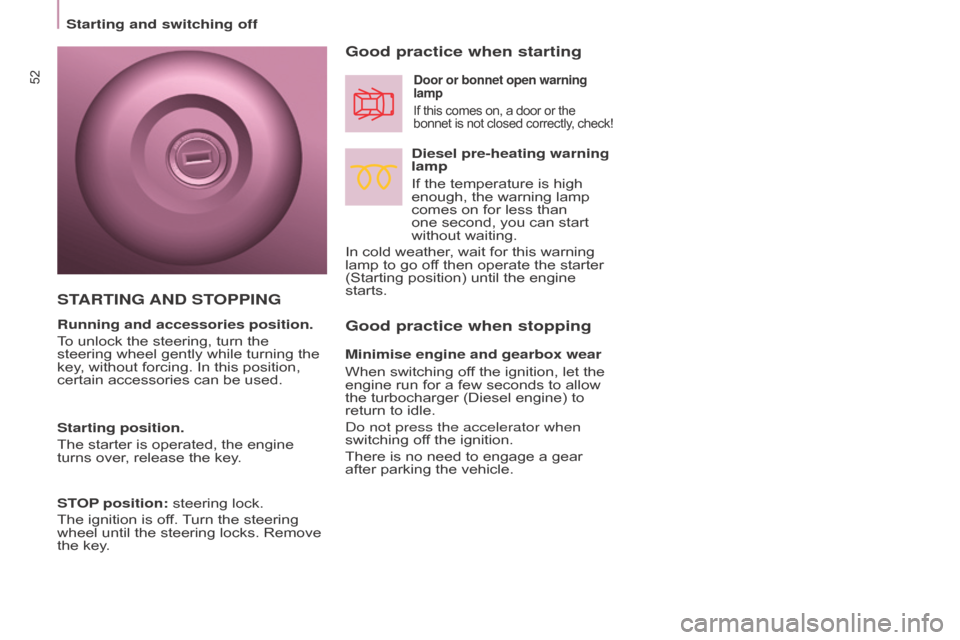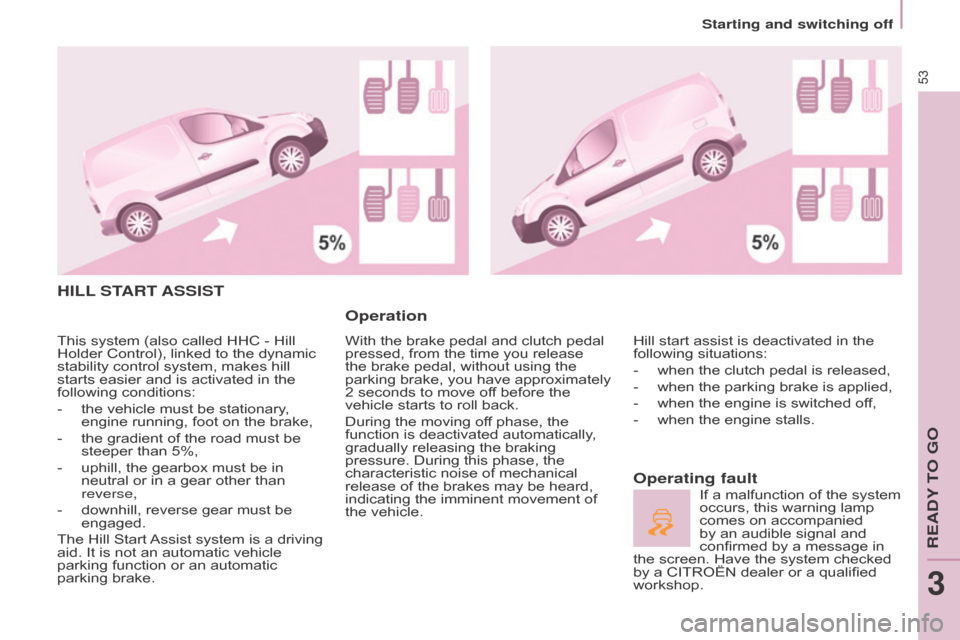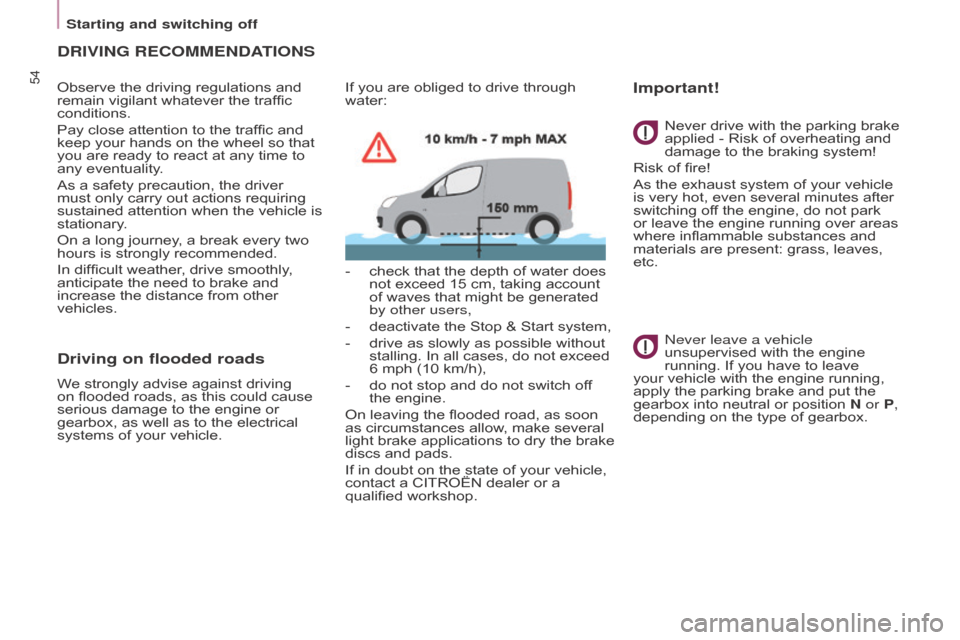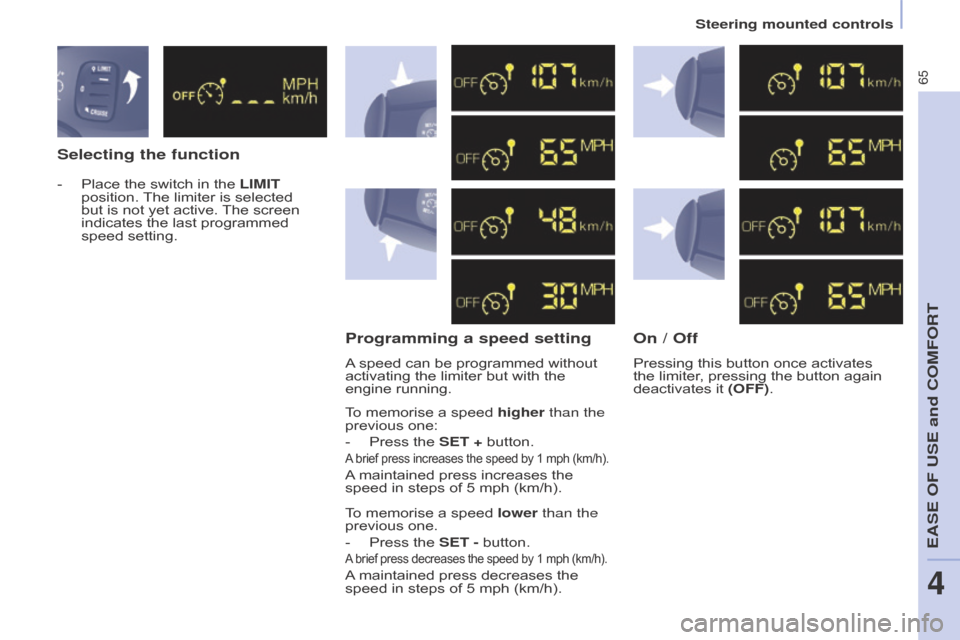engine Citroen BERLINGO RHD 2017 2.G Owner's Guide
[x] Cancel search | Manufacturer: CITROEN, Model Year: 2017, Model line: BERLINGO RHD, Model: Citroen BERLINGO RHD 2017 2.GPages: 260, PDF Size: 8.59 MB
Page 54 of 260

52
Berlingo2VU_en_Chap03_Pret-a-partir_ed02-2016Berlingo2VU_en_Chap03_Pret-a-partir_ed02-2016
Good practice when stopping Good practice when starting
Diesel pre-heating warning
lamp
If the temperature is high
enough, the warning lamp
comes on for less than
one second, you can start
without waiting.
In cold weather, wait for this warning
lamp to go off then operate the starter
(Starting position) until the engine
starts.
Door or bonnet open warning
lamp
If this comes on, a door or the
bonnet is not closed correctly, check!
Minimise engine and gearbox wear
When switching off the ignition, let the
engine run for a few seconds to allow
the turbocharger (Diesel engine) to
return to idle.
Do not press the accelerator when
switching off the ignition.
There is no need to engage a gear
after parking the vehicle.
STARTING AND ST OPPING
Running and accessories position.
To unlock the steering, turn the
steering wheel gently while turning the
key, without forcing. In this position,
certain accessories can be used.
Starting position.
The starter is operated, the engine
turns over, release the key.
STOP position: steering lock.
The ignition is off. Turn the steering
wheel until the steering locks. Remove
the key.
Starting and switching off
Page 55 of 260

53
Berlingo2VU_en_Chap03_Pret-a-partir_ed02-2016Berlingo2VU_en_Chap03_Pret-a-partir_ed02-2016
HILL START ASSIST
Operation
With the brake pedal and clutch pedal
pressed, from the time you release
the brake pedal, without using the
parking brake, you have approximately
2
seconds to move off before the
vehicle starts to roll back.
During the moving off phase, the
function is deactivated automatically,
gradually releasing the braking
pressure. During this phase, the
characteristic noise of mechanical
release of the brakes may be heard,
indicating the imminent movement of
the vehicle.
Operating fault
Hill start assist is deactivated in the
following situations:
-
when the clutch pedal is released,
-
when the parking brake is applied,
-
when the engine is switched of
f,
-
when the engine stalls. If a malfunction of the system
occurs, this warning lamp
comes on accompanied
by an audible signal and
confirmed by a message in
the screen. Have the system checked
by a CITROËN dealer or a qualified
workshop.
This system (also called HHC - Hill
Holder Control), linked to the dynamic
stability control system, makes hill
starts easier and is activated in the
following conditions:
-
the vehicle must be stationary
,
engine running, foot on the brake,
-
the gradient of the road must be
steeper than 5%,
-
uphill, the gearbox must be in
neutral or in a gear other than
reverse,
-
downhill, reverse gear must be
engaged.
The Hill Start
Assist system is a driving
aid. It is not an automatic vehicle
parking function or an automatic
parking brake.
READY TO GO
3
Starting and switching off
Page 56 of 260

54
Berlingo2VU_en_Chap03_Pret-a-partir_ed02-2016Berlingo2VU_en_Chap03_Pret-a-partir_ed02-2016
DRIVING RECOMMENDATIONS
Observe the driving regulations and
remain vigilant whatever the traffic
conditions.
Pay close attention to the traffic and
keep your hands on the wheel so that
you are ready to react at any time to
any eventuality.
As a safety precaution, the driver
must only carry out actions requiring
sustained attention when the vehicle is
stationary.
On a long journey, a break every two
hours is strongly recommended.
In difficult weather, drive smoothly,
anticipate the need to brake and
increase the distance from other
vehicles.
Driving on flooded roads
We strongly advise against driving
on flooded roads, as this could cause
serious damage to the engine or
gearbox, as well as to the electrical
systems of your vehicle.If you are obliged to drive through
water:
-
check that the depth of water does
not exceed 15 cm, taking account
of waves that might be generated
by other users,
-
deactivate the Stop & Start system,
-
drive as slowly as possible without
stallin
g. In all cases, do not exceed
6 mph (10 km/h),
- do not stop and do not switch of f
the engine.
On leaving the flooded road, as soon
as circumstances allow, make several
light brake applications to dry the brake
discs and pads.
If in doubt on the state of your vehicle,
contact a CITROËN dealer or a
qualified workshop. Never drive with the parking brake
applied - Risk of overheating and
damage to the braking system!
Risk of fire!
As the exhaust system of your vehicle
is very hot, even several minutes after
switching off the engine, do not park
or leave the engine running over areas
where inflammable substances and
materials are present: grass, leaves,
etc.
Never leave a vehicle
unsupervised with the engine
running. If you have to leave
your vehicle with the engine running,
apply the parking brake and put the
gearbox into neutral or position N or P,
depending on the type of gearbox.
Important!
Starting and switching off
Page 66 of 260

64
Berlingo2VU_en_Chap04_Ergonomie_ed02-2016
The speed of the vehicle responds to
the pressure of the driver's foot, up
to the the accelerator pedal's point of
resistance, which indicates that the
programmed speed has been reached.
However, pressing the pedal beyond
this point of resistance to the floor
allows the programmed speed to be
exceeded. To resume use of the limiter,
simply reduce the pressure on the
accelerator pedal gradually and return
to a speed below that programmed.
Adjustments can be carried out
when stationary, with the engine
running, or with the vehicle moving.This speed limiter shows the function
selection status in the instrument panel
and displays the programmed speed:SPEED LIMITER
"LIMIT"
Function selected,
displaying of the
"Speed Limiter"
symbol.
Function off,
last programmed
speed - OFF.
Function on.
Vehicle speed above,
the programmed
speed setting is
displayed flashing.
Operating fault
detected,
OFF - the dashes
flash.
1.
Limiter mode On / Of
f.
2.
Reduce programmed speed
setting.
3.
Increase programmed speed
setting.
4.
Speed limiter On / Pause.
"This is the selected speed which the
driver does not wish to exceed".
This selection is made with the engine
running while stationary or with the vehicle
moving. The minimum speed which can be
programmed is 20 mph (30 km/h).
Steering mounted controls
Page 67 of 260

65
Berlingo2VU_en_Chap04_Ergonomie_ed02-2016
Selecting the functionProgramming a speed setting On / Off
To memorise a speed higher than the
previous one:
-
Press the
SET + button.
A brief press increases the speed by 1 mph (km/h).
A maintained press increases the
speed in steps of 5 mph (km/h).
To memorise a speed lower than the
previous one.
-
Press the
SET - button.
A brief press decreases the speed by 1 mph (km/h).
A maintained press decreases the
speed in steps of 5 mph (km/h).
-
Place the switch in the
LIMIT
position. The limiter is selected
but is not yet active. The screen
indicates the last programmed
speed setting.
A speed can be programmed without
activating the limiter but with the
engine running. Pressing this button once activates
the limiter, pressing the button again
deactivates it (OFF).
Steering mounted controls
EASE OF USE and COMFORT
4
Page 70 of 260

68
Berlingo2VU_en_Chap04_Ergonomie_ed02-2016Berlingo2VU_en_Chap04_Ergonomie_ed02-2016
Intake of exterior air
Recirculation of interior airAir conditioning A/C
The LED in the button is
off. This is the preferred
operating position.
Pressing the button starts
the air conditioning system,
the LED is on. Pressing the
button again switches the
function off and the LED
goes off.
The air conditioning does not operate if
the fan speed is set to 0. The air conditioning can only operate
with the engine running.
The LED in the button is on.
Recirculation temporarily
prevents exterior odours
and smoke from entering the
passenger compartment.
Used with the setting of the fan speed
(from 1 to 4), recirculation enables you
to attain the desired comfort level more
quickly with both hot or cold settings.
This position should only be temporary.
When your desired comfort level has
been reached, return to the intake
of exterior air position to permit
renewal of the air in the passenger
compartment and avoid misting. This is
the preferred operating mode.
Ventilation
Page 71 of 260

69
Berlingo2VU_en_Chap04_Ergonomie_ed02-2016Berlingo2VU_en_Chap04_Ergonomie_ed02-2016
Good practice
For maximum cooling or heating of the
passenger compartment, it is possible
to exceed the value 15 by turning until
LO is displayed or the value 27 by
turning until HI is displayed.
On entering the vehicle, the inside
temperature may be much colder (or
warmer) than is comfortable. There is
no advantage in changing the value
displayed in order to quickly reach the
level of comfort required. The system
will use its maximum performance to
reach the comfort value set.
DIGITAL AIR CONDITIONING
Automatic operation
AUTO comfort programme
This is the normal air conditioning
system operating mode. Driver or passenger side comfort
value
The value indicated in the screen
corresponds to a level of comfort and
not a temperature in degrees Celsius
or Fahrenheit.
Turn this control to the left
or to the right to decrease or
increase the value. A setting
around the value 21 provides
optimum comfort. However,
depending on your requirements, a
setting between 18 and 24 is usual.
Do not cover the sunshine sensor
located on the dashboard.
Press this button, the AUTO
symbol is displayed.
The system controls the
distribution, the flow and the
intake of air to guarantee
comfort and a sufficient circulation
of air in the passenger compartment
according to the comfort value set. No
further action on your part is required. Air flow will increase gradually when
the engine is cold, to prevent excessive
distribution of cold air.
For your comfort, the settings are
stored when the ignition is switched off
and are reinstated the next time the
vehicle is started.
The automatic function will no longer
be maintained if you change a setting
manually (AUTO is cleared).
SEPARATE SETTINGS FOR DRIVER AND
PASSENGER
EASE OF USE and COMFORT
4
Ventilation
Page 74 of 260

72
Berlingo2VU_en_Chap04_Ergonomie_ed02-2016Berlingo2VU_en_Chap04_Ergonomie_ed02-2016
DEMISTING AND DEFROSTING
Manual mode
Turn the control to this
temperature setting.
Increase the air flow setting.Press the air conditioning
button.
Returning to exterior air
intake open permits renewal
of the air in the passenger
compartment (LED off).
Turn the control to this air
distribution setting.
Demisting the rear screen and/
or mirrors
Pressing this button, with the
engine running, activates the
rapid demisting - defrosting of
the rear screen and/or electric
mirrors.
This function switches off:
-
when the button is pressed,
-
when the engine is switched of
f,
-
automatically to prevent excessive
energy consumption.
Ventilation
Page 98 of 260

96
Berlingo2VU_en_Chap05_Securite_ed02-2016
ANTI-SLIP REGULATION (ASR)
AND
DYNAMIC STABILITY
CONTROL (DSC)
These systems are linked and
complement the ABS.
The ASR system is very useful for
maintaining optimum drive and
avoiding losses of control of the vehicle
on acceleration.
The system optimises drive to prevent
the wheels skidding, by acting on the
brakes of the drive wheels and on the
engine. It also allows the directional
stability of the vehicle to be improved
on acceleration.
Use the DSC to hold your course
without attempting to countersteer.
If there is a variation between the
trajectory followed by the vehicle and
that required by the driver, the DSC
system automatically acts on the
engine and the brake of one or more
wheels, in order to put the vehicle back
on course.
Deactivation
In certain exceptional conditions
(starting the vehicle when stuck in mud
or snow, or on loose ground...), it could
prove useful to deactivate the ASR and
DSC systems to make the wheels spin
and regain grip.
Operating fault
Good practice
The ASR/DSC systems offer increased
safety during normal driving, but
should not incite the driver to take risks
or to drive at high speed.
The operation of these systems is
ensured if the recommendations
of the manufacturer regarding
the wheels (tyres and rims), the
braking components, the electronic
components and the fitting and repair
procedures are observed.
After an impact, have these systems
checked by a CITROËN dealer or a
qualified workshop.
Operation
The warning lamp flashes
when operation of the ASR or
DSC is triggered.
They engage again:
-
automatically above 30 mph
(50 km/h), When a malfunction of the
systems occurs, the warning
lamp and the LED come on,
accompanied by an audible
signal and a message in the
screen.
Contact a CITROËN dealer or a
qualified workshop to have the system
checked.
The warning lamp may also come on if
the tyres are under-inflated. Check the
pressure of each tyre.
-
Press the button or turn
the dial to the DSC OFF
position (depending on
model).
-
The LED comes on: the
ASR and
DSC systems no longer come into
play.
-
manually by pressing the
button again or by turning
the dial to this position
(depending on model).
Driving safely
Page 99 of 260

97
Berlingo2VU_en_Chap05_Securite_ed02-2016
GRIP CONTROL
It adapts to allows most conditions of
poor grip to be accommodated.
The accelerator pedal must be pressed
enough for there to be adequate
engine power to manage the various
parameters in the best way. On snow, mud or sand, traction control
is obtained by a compromise between
safety, grip, traction and appropriate
tyres. Correct use
Your vehicle is designed principally to
drive on tarmac roads but it allows you
to drive on other less passable terrain
occasionally.
However, particularly when your
vehicle is heavily laden, it does not
permit off-road activities such as:
-
crossing and driving on ground
which could damage the underbody
or tear of
f components (fuel pipe,
fuel cooler, ...), particularly by
obstacles or stones,
-
driving on ground with steep
gradients and poor grip,
-
crossing a stream.
Driving safely
SAFETY
5